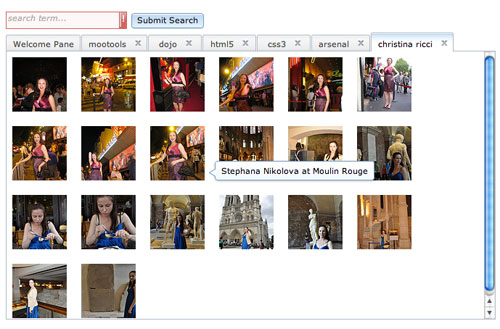Dear Developers, Don’t Hardcode Copyright Years
Keeping your website current is extremely important when your goal is increasing return traffic. One easy place to make your website look current is in the copyright text at the bottom of the page. This is a rather obvious and easy thing to do, but some sites have overlooked their copyright year.
Offender 1: Google Analytics

Offender 2: Cedant Web Hosting

Offender 3: VH1

Offender 4: Kraft Foods

Offender 5: MooTools

Offender 6: Manning Publications

Offender 7: Prototype JS

Offender 8: Rock Band

The moral of the story? Don't hardcode your site's copyright year unless you must legally keep a specific year.
![Welcome to My New Office]()
My first professional web development was at a small print shop where I sat in a windowless cubical all day. I suffered that boxed in environment for almost five years before I was able to find a remote job where I worked from home. The first...
![9 Mind-Blowing WebGL Demos]()
As much as developers now loathe Flash, we're still playing a bit of catch up to natively duplicate the animation capabilities that Adobe's old technology provided us. Of course we have canvas, an awesome technology, one which I highlighted 9 mind-blowing demos. Another technology available...
![Create a Dynamic Flickr Image Search with the Dojo Toolkit]()
The Dojo Toolkit is a treasure chest of great JavaScript classes. You can find basic JavaScript functionality classes for AJAX, node manipulation, animations, and the like within Dojo. You can find elegant, functional UI widgets like DropDown Menus, tabbed interfaces, and form element replacements within...
![dat.gui: Exceptional JavaScript Interface Controller]()
We all love trusted JavaScript frameworks like MooTools, jQuery, and Dojo, but there's a big push toward using focused micro-frameworks for smaller purposes. Of course, there are positives and negatives to using them. Positives include smaller JS footprint (especially good for mobile) and less cruft, negatives...













From one of my templates:
Looks a bit ugly but does the trick just fine. ;)
That should have been:
print(gmdate('Y')!='2005'?'2005-'.gmdate('Y'):gmdate('Y'));(I hope it works now… a preview button would have been nice by the way.)
Jos: Absolutely. Here’s what I use for this site:
echo date('Y') == '2007' ? '2007' : '2007 - '.date('Y');Obviously I hardcode 2007 because that’s the year the blog started.
I always would notice that Google would change their copyrights on the day of new years. I was always impressed that they were on top of it.
Later I realized that they just pull it from the date on the server. From then on I have always done it that way. I am suprised that you found so many sites that are out of date.
the need for copyright is only necessary when there’s new content on the site… so if they haven’t made changes in 2008, there’s no need to copyright it for this year until new content appears.
i’m just sayin’. i use server-side though. :)
var d = new Date(); document.write(d.getFullYear());I use PHP to echo whatever the current year is – so my copyright updates at midnight on New Year :)
Hey guys Just do:
and thats it.
Hey guys Just do:
echo date("Y");and thats it.I’m never sure of what sort of rules there are on this sort of thing. If anyone could point me to a nice resource on website copyrights it would be much appreciated. :)
I also look at copyright notices to check how “fresh” a Web site is, so I basically agree with this post. However, it’s important to keep in mind that changing the copyright date at the bottom of each page on your site really has nothing to do with a legal copyright. Once you’ve published an item, the copyright date is set. So, if I posted an article on my blog in 2006, it still has a copyright of 2006, no matter what copyright date is listed at the bottom of the Web page. In addition, if you ever did run into a case where a site was infringing the copyright of some of your content, you’d want the original copyright date to prove that your content preceded what appears on the copycat site.
Here is the code I use on my classic asp pages.
Copyright © 1998 – <%=Year(Date)%&rt;
And for ASP.NET
Copyright © 1998 – <%=DateTime.Now.Year()%- &rt;
Here is the code I use on my classic asp pages.
Copyright © 1998 – <%=Year(Date)%>
And for ASP.NET
Copyright © 1998 – <%=DateTime.Now.Year()%>
(Sorry about the double post. I second the preview idea!)
I guy I met once, used to have some text in his website’s footer stating ‘Page last updated DD-MM-YYYY’ which just showed that days’ date pulled in with PHP. His boss thought he was so hard working, updating the site every day!
@Phil: Hilarious!
@bekee:
Try that and you’ll may notice a *slight* difference between IE 6 and 7.
That gave me a lot of headaches until I found this:
http://www.quirksmode.org/js/introdate.html
enjoy.
The question is not to find a nice way to print the current year in the footnote (even a newby can do that), but whether which year should be displayed, and if the copyright notice should be printed at all.
Under the 1886 Berne Convention, copyrights for creative works do not have to be asserted or declared, as they are automatically in force at creation. Most developed countries in the world signed the Berne convention.
Instead, the USA and most Latin American countries entered into the Buenos Aires Convention in 1910, with which a copyright notice was part of statutory requirements.
The world trade organization incorporated the Berne convention in its TRIP agreements in 2002.
Hence, this notice is pointless, because author ownership is automatically acknowledged.
@Régis: That explanation was incredible — thank you! That said, if the notice is pointless, it may as well display the current year.
While it’s true that just posting unique content to a Web page automatically gives copyright ownership to the author, if you really want to assert a copyright you should put a copyright notice and date on the published content. In the US, if you are afraid that the copyright on your material might be infringed by a third party you should register your copyrighted material with the US Copyright Office–this is the best way to establish copyright date, and is required if you ever need to take legal action against someone infringing your content. This is probably too much work for most content–especially blog posts and other shorter content–but if you were Web site were totally dependent upon ownership of your content (like a complete book you placed online), it’s worth looking into registering your copyrighted material. YOu can find some more info here: http://www.copyrightkids.org/cbasicsframes.htm
It’s an hypothesis, but maybe theses bigs companies hardcode the copyright strings in their template to same some CPU during the page generation. For a blog or a website with few visitors, it’s a great idea to use
Date('Y'); but when you have a lot of visitors (example, google, facebook, …) this could help to save maybee, few milliseconds, but also few servers, for maybe, depending of your opinion, a little detail ^^i always use
Back when I worked for a Large Computer Manufacturer (who no longer exists), we were told by our company lawyers that “Copyright … 1998-2002” was a defective notation, and that we must use “Copyright … 1998, 1999, 2000, 2002” even when it got long and unwieldy, and also including only the years in which the work was actually changed. Since they were large and scary lawyers, we complied, and I have been doing it that way ever since. If you have larger and scarier lawyers who can rebut this, I will be pleased to lay down my mental burden.
It is the other way around.
Copyright year should be hardcoded, since it does not translate to another year by itself, especially not at midnight of 31 December.
Writing it in the code is a developer’s shortcut, not a decision of any legal department.
You can actually make copyright for next year by the end of previous year. This is frequently done for the books. That is a prediction.
So, legally, no, it is not correct to shift copyright like that. There has to be one step of approval in between.
The problem is that copyright covers as much the Website design as much the service you are offering.
Putting copyright and setting year to change in the code, is really NOT what copyright is about, although if you forget to update and you are already in March and all is OK with the company that will catch a negative attention.
So careful there, most obvious practice can cost.